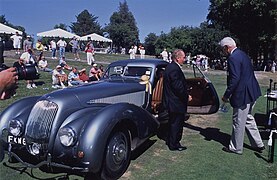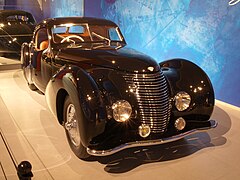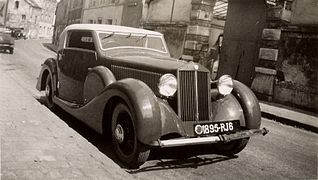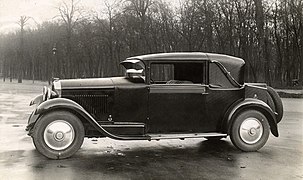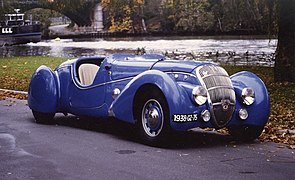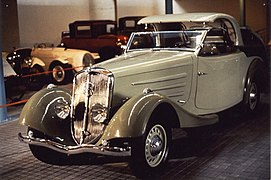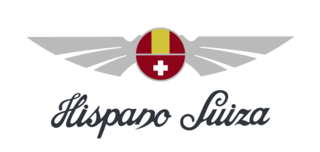
Hispano-Suiza is a Spanish automotive–engineering company. It was founded in 1904 by Marc Birkigt and Damian Mateu as an automobile manufacturer and eventually had several factories in Spain and France that produced luxury cars, aircraft engines, trucks and weapons. In 1923, its French luxury car arm became a semi-autonomous partnership with the Spanish parent company. In 1946, the Spanish parent company sold all of its Spanish automotive assets to Enasa, a Spanish state-owned vehicle manufacturer, and the French arm continued as an independent aviation engine and components manufacturer under the Hispano-Suiza name. In 1968, Hispano-Suiza was taken over by the aerospace company Snecma, which is now part of the French Safran Group. An attempt to relaunch the marque was made by the company Hispano Suiza Cars associated with the Peralada Group in 2019 with a fully-electric car.

Delage is a French luxury automobile and racecar company founded in 1905 by Louis Delâge in Levallois-Perret near Paris; it was acquired by Delahaye in 1935 and ceased operation in 1953.

Delahaye was a family-owned automobile manufacturing company, founded by Émile Delahaye in 1894 in Tours, France. Manufacturing was moved to Paris following incorporation with two unrelated brothers-in-law as equal partners in 1898. The company built a low volume line of limited production luxury cars with coachbuilt bodies; trucks; utility and commercial vehicles; busses; and fire-trucks. Delahaye made a number of technical innovations in its early years; and, after establishing a racing department in 1932, the company came to particular prominence in France in the mid-to-late 1930s, with its Type 138, Type 135SC, and type 145 cars winning numerous races, and setting International records. The company faced setbacks due to the Second World War, and was taken over by amalgamation with arch competitor Hotchkiss in 1954. Both were taken over by the Brandt organization, within mere months, with automotive product manufacturing ended.

A coachbuilder or body-maker is a person or company who manufactures bodies for passenger-carrying vehicles. Coachwork is the body of an automobile, bus, horse-drawn carriage, or railway carriage. The word "coach" was derived from the Hungarian town of Kocs. A vehicle body constructed by a coachbuilder may be called a "coachbuilt body" or "custom body".
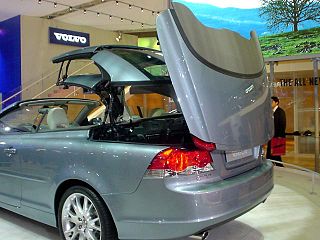
A retractable hardtop — also known as "coupé convertible" or "coupé cabriolet" — is a car with an automatically operated, self-storing hardtop, as opposed to the folding textile-based roof used by traditional convertible cars.

Musée National de l’Automobile, Collection Schlumpf is an automobile museum located in Mulhouse, France, and built around the Schlumpf Collection of classic automobiles. It has the largest displayed collection of automobiles and contains the largest and most comprehensive collection of Bugatti motor vehicles in the world.

Georges Paulin was a French Jewish dentist, acclaimed and inventive automobile designer and coachwork stylist, and died as a hero of the French Resistance during World War II.

The Lancia Augusta is a small passenger car produced by Italian car manufacturer Lancia between 1933 and 1936. It made its première at the 1932 Paris Motor Show. The car was powered by a 1,196 cc Lancia V4 engine.

The Peugeot 402 is a large family car produced in Sochaux, France from 1935 to 1942 by Peugeot. It was unveiled at the Paris Motor Show in 1935, replacing the Peugeot 401.

The Peugeot 401 was a mid-size model from Peugeot produced in 1934 and 1935. It was introduced at the October 1934 Paris Motor Show and was again on display at the 29th Paris Show of 1935.

The Peugeot 601 was a range-topping car produced between 1934 and 1935 by Peugeot. It had its formal launch on 5 May 1934 and marked a return by the manufacturer to six-cylinder engines.

The Hispano-Suiza J12 is a luxury automobile that was made by Hispano-Suiza in France from 1931 to 1938. It was the largest and most expensive car ever built by Hispano-Suiza. It replaced the Hispano-Suiza H6. The J12 was only available as a chassis, buyers having to arrange with an outside coachbuilder to integrate a body.
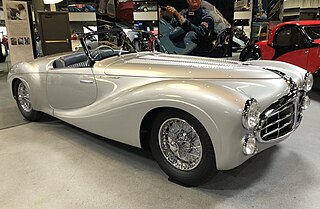
Founded by cabinet maker Jacques Saoutchik, Saoutchik was a French coachbuilding company founded in 1906. In the 1930s, the company became well known for their often extravagant automobile designs for high end luxury car manufacturers. After Jacques died in 1955, the company passed into the hands of his son Pierre. With most of the well known French luxury car manufacturers going out of business and independent automotive coachbuilding as an industry in decline, the market for Saoutchik designs evaporated and the company ceased trading in 1955.
France was a pioneer in the automotive industry and is the 11th-largest automobile manufacturer in the world by 2015 unit production and the third-largest in Europe. It had consistently been the 4th-largest from the end of World War II up to 2000. It is 16% of sales of French manufactured products.
Figoni et Falaschi is a French luxury brand and coachbuilder firm which was active from 1935 through to the 1950s. The designs were created by Giuseppe Figoni, while his partner Ovidio Falaschi ran the business.

Carrosserie Vanvooren was a French Coachbuilder based in the north-western Paris suburb of Courbevoie. The company concentrated on producing car bodies for luxury cars, being closely associated, during the 1930s, with the products of Hispano-Suiza, Bugatti, Rolls-Royce and Bentley.

The Delage D6 is a six-cylinder luxury car produced by the manufacturer between 1930 and 1940 and again, after the war, between 1946 and 1953. For much of this time it was the company’s principal or, from 1946, only model.
Franay was a French coachbuilder operating at Levallois-Perret, a suburb on the prosperous north-western edge of Paris. The company was founded in 1903 by Jean-Baptiste Franay, a carriage upholsterer, following an apprenticeship with Binder. It was later taken over by his son, Marius. Franay car body production stopped in late 1955.

The Hispano-Suiza H6B Dubonnet Xenia is a one-off luxury car made by Spanish automobile manufacturer Hispano-Suiza for French pilot and racing car driver André Dubonnet in 1938. The car was built on the chassis of the Hispano-Suiza H6B, however it uses the larger, more powerful engine from the H6C and an entirely new body design by luxury coachbuilder Jacques Saoutchik.

Belvallette Frères, often spelled “Belvalette Frères”, was a French company that manufactured carriages and other vehicles.









